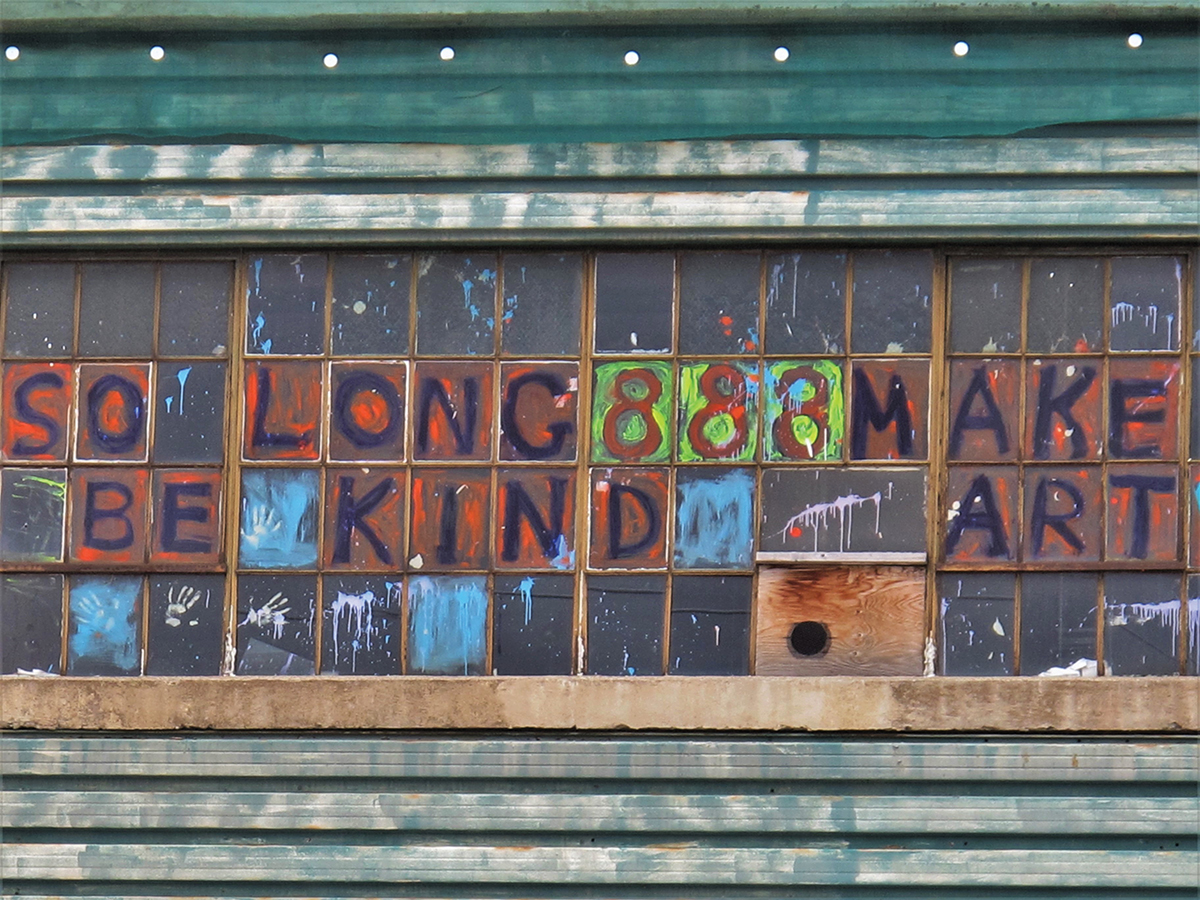
The windows of 888 Dupont, after the artists and businesses that called it home were evicted this spring.
“Don’t we all go by here a million times a month?” I once wrote about 950 Dupont Street, at the corner of Dovercourt Road, in Toronto. At the entryway, a larger-than-life image, seemingly etched in glass, of a mustachioed man from a century ago, greets visitors. He stands in his overalls, next to a massive industrial gear, such as were once made here, when it was the Hamilton Gear factory. One day last year, I went inside, unannounced. I spotted the silver-haired Patrick Johnson at the back. It had been sixteen years since I last came by, but Johnson remembered me. We swapped pleasantries across the big room. “He bought a hutch,” Johnson told one of his sons, who, I can safely say, had grown up since I was last there. Talk about a memory: in 1967, my parents purchased two (actually) pine Québécois hutches from Johnson’s dad’s furniture store, in Ottawa’s ByWard Market. “I remember sanding those things as a kid,” Johnson says. “They were gorgeous.” (Yes, they were.)
I also once wrote “so far, so good” describing his efforts to redeploy the old industrial plant as a furniture outlet, incubator spaces, and whatever else might generate income. In 2006, Johnson told me he bought the factory after studying its bones: the translucent pavilion at the corner that I called “a muscular cage of I-beams that seem one with the steel windows”; a section along the adjacent Canadian Pacific Railway tracks, with a saw-tooth roof, “rows of skylights tilted toward the northern sky—the classic factory roofs of toy train layouts.” The deal came with enough junk to fill a dump, cellar reservoirs filled with waste oil, and the benefit of a stale real-estate listing (“unsellable,” in realtor lingo) during the mid-nineties recession.
“Do you want to see it?” asked Johnson, during my latest visit. “Do you want to see what’s going on? Come with me.” Off we went and stepped into an old elevator. Slam, bang, a gate was pulled shut. Jane Jacobs wrote, in The Death and Life of Great American Cities, that cities “need old buildings,” that “new ideas of any kind” must use old buildings. Mainly because—aesthetic and cultural reasons aside—the rent is usually lower. Johnson’s bid to find tenants for the old gear complex’s every nook and cranny speaks to that aspiration.
The prospect of too much decrepitude ended as we exited into the building’s third floor, where a wide, long, tall room sat ready. We walked to the far end, where a man was prepping the floor, which had been ground smooth and was to be polished to a shine. At the time of my visit, the space had just been rented. Each storey is double height, placing the third floor far above the street. Ribbons of floor-to-ceiling windows ran the length on both sides, with views to the south overlooking Dupont, and north over the saw tooths, past the train tracks, to trees and houses on the rise beyond Davenport Road.
The layout was similar one floor below, except for a newish open stairway of concrete and glass that led up from the foyer below. This floor was occupied throughout the pandemic. At the near end was a chic bar. Juice? Fancy espresso? Something stronger? Young people in masks were seated with laptops and smartphones. Rows of long tables were set out. Upon them were computers, rolls of paper, and model buildings and the materials to make them. “Architects. They rented this floor,” said Johnson, who moved quickly with me in tow, speaking softly, so as not to disturb his tenants. On one of the tables, I spotted a vintage Kenner Girder and Panel building set, such as I had when I was a boy.
On this tour, I followed in the footsteps of Donald Weston, a long-time employee of Hamilton Gear, whom I interviewed for a 1998 feature in this magazine, “Dupont at Zenith.” A few years earlier, Weston had walked around the dying gear factory with a video camera on his shoulder. In one scene, he emerged into a huge glass shed, the one familiar to Torontonians as they pass by the factory today. Johnson has faced challenges finding uses for this part of the building. Weston told me of trouble doing precision work, due to temperature fluctuation. Johnson used the room to store the furniture he sold in his ground-floor showroom. Bellwoods Brewery considered moving in, but didn’t. Clothier Frank and Oak held a warehouse sale here. The rental muse seemed to reward Johnson’s patience with Second Sky, a company that offered private training in the circus arts. Peeking in once, I saw dangling ropes and hanging banners under the forty-foot ceiling, the structure’s beams of bare steel seemingly tailor-made for training in aerial acrobatics and flying trapeze. But Second Sky didn’t stay, and the musical chairs delivered Uchenna Academy, a post-secondary prep school focused on academics and athletics, which installed a gleaming wood gym floor and partnered, in the adjacent annex, with BallMatics, an institute that somehow combines math study and basketball.
Here was the prototype for a new-age Dupont Street, I thought, when I first saw what Johnson was doing. He called his place the Hamilton Gear Building, playing its machine-age past with the idea of ushering in a high-tech, or whatever, future. Executing his vision took more than twenty years. If Johnson’s rents aren’t as low as in the old broom factory down the street, the cool factor, not to mention the luxury of shiny floors and fancy lighting at 950 Dupont, is worth the premium. Where else was the virtual greeter a literal gearhead—that heroic figure, embossed on plate glass in the foyer? From what I could see, all up and down Dupont Street, interesting old factories lay in wait for similar transformation.
During this past winter, I wrote to a friend, “The gear factory is owned by a gentleman and his sons who enjoy the challenges it presents. He bought it derelict 26 years ago, has gradually rounded up the capital needed to redeploy it in ways tuned to its bones.” I added, “The jeopardy is simply, what if someone comes along who offers his family $100 million? Who needs the trouble of finding a circus act to fill the glass shed?”
One afternoon around that same time, I parked my Smart car on the south side of Dupont and dashed across to the Farm Boy grocery store, located in the new Litho apartment block. In the fall of 2021, when the large middlebrow Sobeys supermarket just up the street closed to make way for another condo, a sign on the door suggested, “Come See Us at Sobeys Danforth,” in Toronto’s east end. Not so handy.
But Google around and you learn Farm Boy grew from a produce store in Cornwall, Ontario, into, as the Toronto Star put it, “A fresh take on the grocery store,” not as hip as the midtown Summerhill Market, perhaps, but an “upgrade” befitting “The New Dupont”—the secondary slogan of seemingly almost every development on the street. You also learn about Farm Boy what Sobeys doesn’t say: it’s just Sobeys in designer clothes. Sobeys owns it.
I made it across to Farm Boy’s automatic door. One of Dupont’s good points is that it is not a food desert. Leon Weinstein opened one of his Power stores at the corner of Huron Street in the nineteen-fifties, when supermarkets were new. In the nineties, Loblaws built the prototype for its corporate future, the urban upscale superstore, at the corner of Christie, today with orange floors and, under studio lighting in jewel-like cases at its entrance, pyramids of macarons and banks of pastry to whet the appetites of grocery-getters. Those kinds of enticements were a trial run for the later, absurdly upmarket Maple Leaf Gardens Loblaws, a national shrine to hockey, now with a cheese wall. Farm Boy raised the bar further for urbanity on Dupont, with indoor parking. I needed to buy something to make my first visit real. Reaching for pomegranates to take home, I encountered Mikey the monkey, a stuffed ape that hangs from something vine-like in Farm Boy produce sections. He was signaling where the bananas were, but also, it was becoming clear, that Dupont Street might be heading in a direction different from what I’d originally thought.
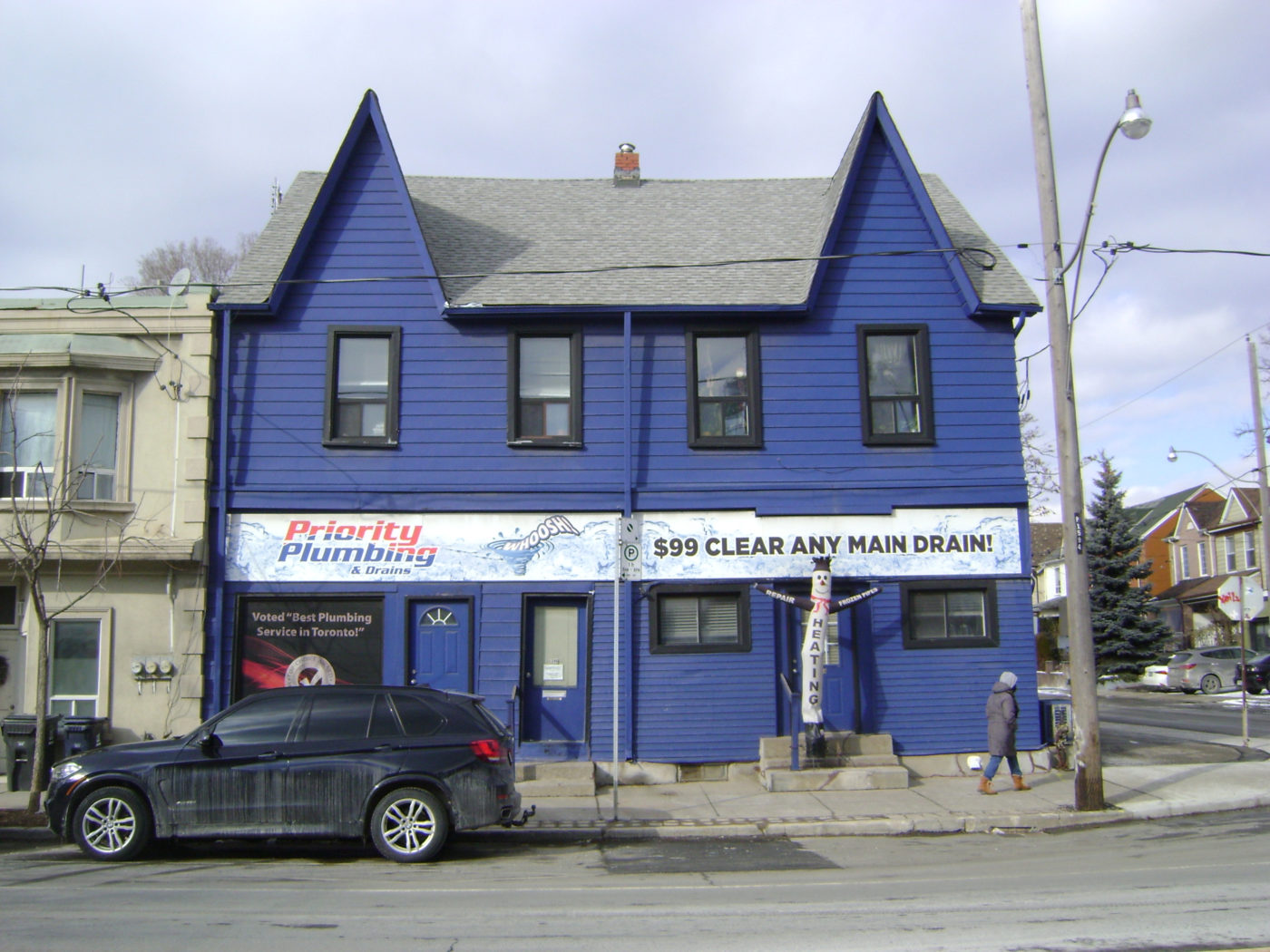
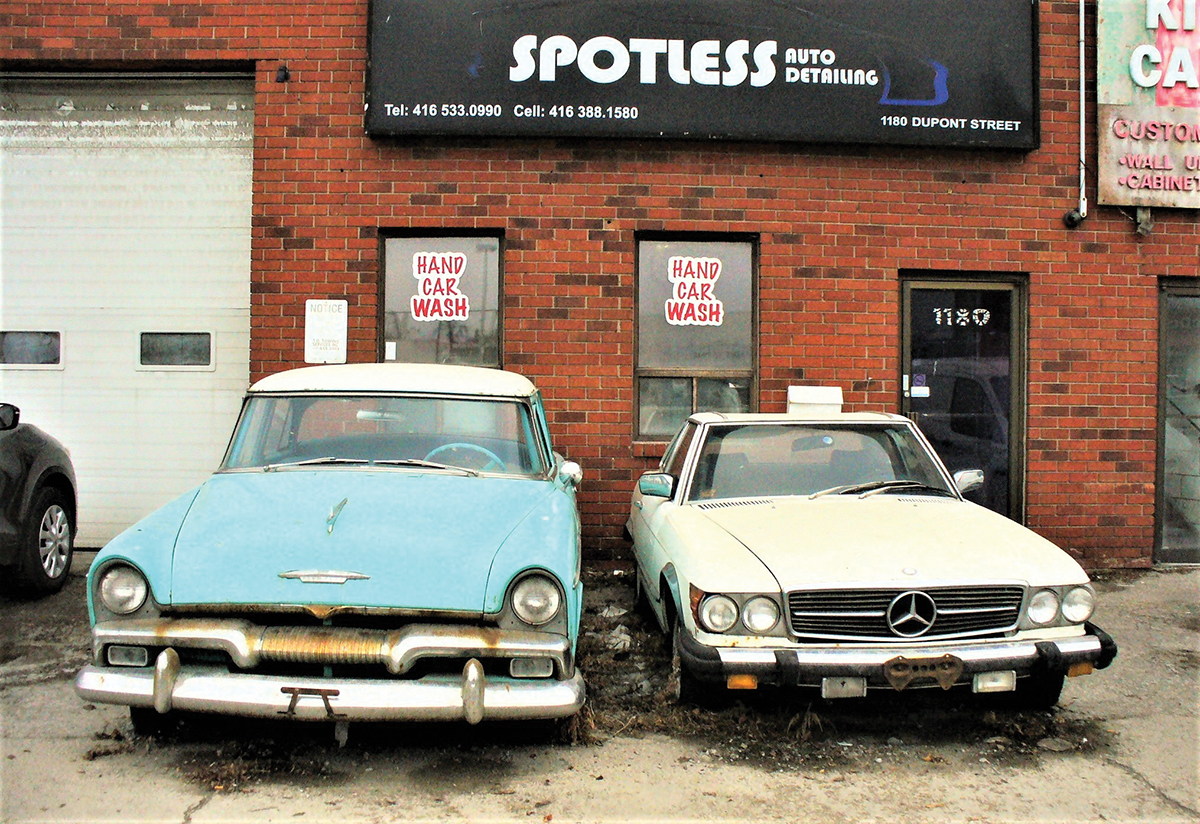
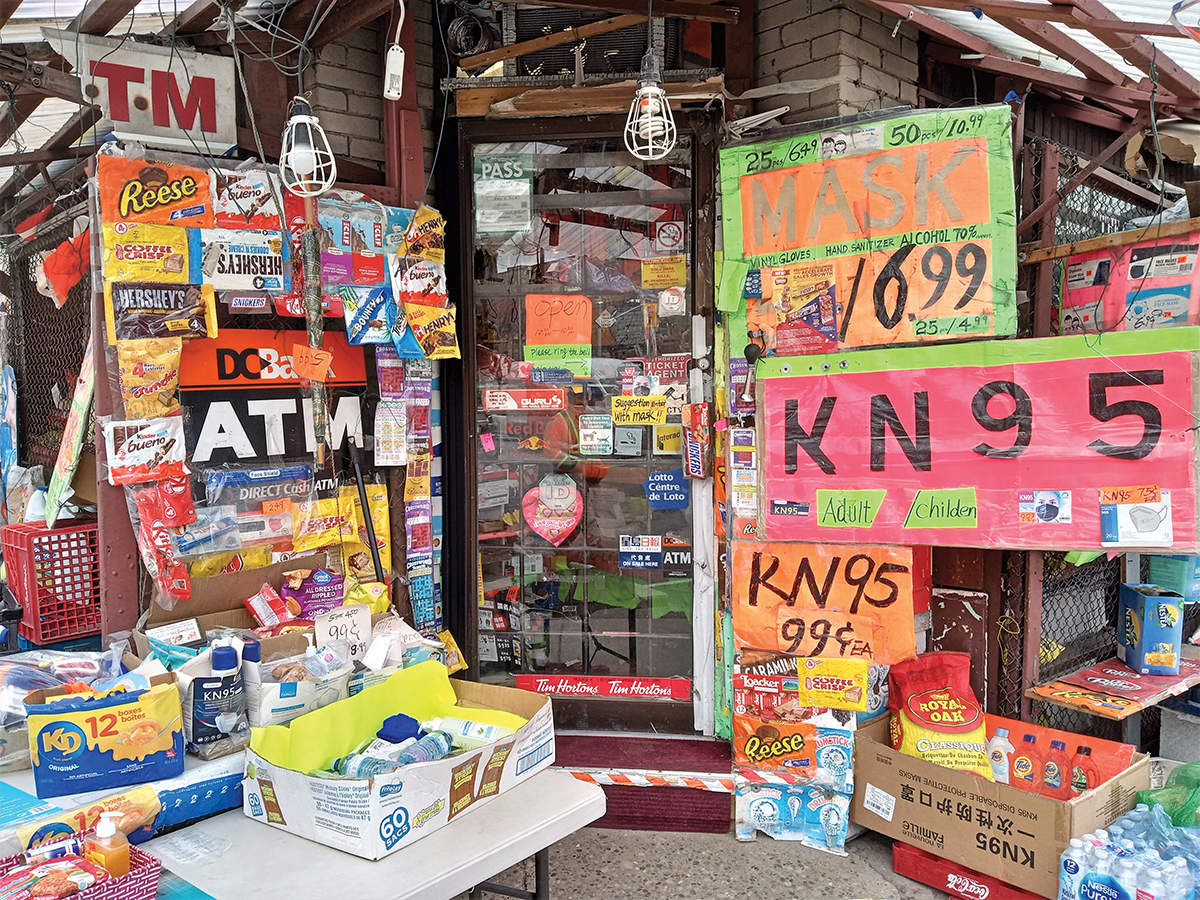
“Rendering is artist’s impression only. Architectural features and materials are representational only and subject to change. Views are not guaranteed.” In a bird’s-eye rendering of a grand boulevard, wide sidewalks are populated by idling flâneurs. The traffic, in this mythical picture of a day in the future, is light. It must be late afternoon, mid-summer, because the sun has come around and warm light, a hazy Parisian shimmer, is raking across the north façades of new condominiums along the south side of Dupont. The word “Air” glows in the space around the buildings’ summits. If the towers were taller and skinnier, that might well be New York’s Central Park across the street. But looking closely—are those railway tracks, threading among the trees? And isn’t that Spotless Auto Detailing at the corner, its mascot, a turquoise 1955 Plymouth with flat tires, parked outside? The nondescript building, which also houses Portugal Kitchen Cabinets and an audio store, is there, all right. This is not Paris or New York, I see, but Dufferin and Dupont.
The image is a sales pitch, found online. But if you’re reading this in 2025 and go over to check it against reality, it will all likely be there: the round-edge flatiron tower near the corner, with motifs said to be inspired by a radiator (such as were once made at a factory here); a pedestrian plaza between more towers, lined with stores, including a supermarket and sidewalk cafés; rows of trees and planters; more towers, different towers.
Developer ELAD Canada calls Galleria on the Park “master planned.” In an online promo video, the viewer flies like the Jetsons around a virtual city skyline with views of a district long occupied by a low-end mall and a McDonald’s, now being turned into something akin to Radiant City. Under construction are five hectares of condominiums adjoining three hectares of parkland. It was huge compared to other contemporary projects, and generated its share of NIMBY (not in my backyard) angst. There was concern about traffic, and regret at losing stores and public space in the downscale Galleria mall. A good word was put in for the Wallace Emerson complex, a city community centre adjacent to the shopping mall, also being torn down to make way. In 1982, the building won a Governor General’s medal for architecture. Forty years on, a newspaper columnist thought there was life left in its brutalist ramparts. But brutalism is a hard sell. Dupont Street being, still, an edge more than a core, a border zone not as sternly curated by surrounding neighourhood groups. “Though it seems like cranes are everywhere in the city, they’re actually confined to relatively few areas where multi-unit buildings are allowed to be built,” wrote the urbanist Shawn Micallef, mentioning Dupont Street and the Galleria in his Star column.
But who really dreaded the transformation of gritty Dupont into a grand boulevard, if that seemed a possibility? It was a virtual fait accompli in the fancy magazine created to promote the high-end Bianca, printed on heavy-stock paper, with a table of contents and bylined feature articles. Located east of Bathurst Street, Bianca is in Toronto’s historic and expensive Annex, with condominiums “starting at $1.3 Million.” To set the needed tone, the magazine offered, among other arts and lifestyle features, “Diva Dogs on Dupont,” informing, “Whether you’re outfitting a dashing Doberman, a neat Newfie, or a posh Poodle, there are sassy stores close by.” The building’s lead architect, Stephen Teeple, is pictured in the promo book with a red and black motorcycle. In an interview, he reveals less-known Dupont data, such as why all the new condo buildings step back in 1916 New York style (well, sort of), as they rise up: “Zoning laws in Toronto require mid-rise condominiums to be built at a 45-degree angular plane from the property line.” Rising from the Dupont sidewalk, the Bianca goes up in a 3-D kind of way, the apartment below becoming the terrace for the one above. It suggests “a mediterranean hilltop village,” according to Teeple partner Martin Baroni, aping what Moshe Safdie had in mind for the puzzle-like Habitat, at Expo 67, in Montreal. Imagine that future—no, see it in the present; Bianca has been built—on Dupont Street in Toronto.
One of the vexing problems posed when a city experiences an endless real estate boom showed up a few blocks east of the Galleria, west of Bianca, where Dupont Street makes its diagonal jog across Ossington Avenue. As of spring, 2022, 888 Dupont was covered in the less-artful kind of graffiti that arrives like lightning when an address is emptied. In May, a wire fence appeared around the perimeter, and demolition crews began work inside. The building may be gone when you read this, after long service to many: to Thomas Oswald Aked, the yarn spinner and original 1921 owner of 888, to an epoch of blind broom makers, to the artists who most recently used its lofts to work and clandestinely live. “Pieces exhibited in the [Art Gallery of Ontario] were painted there,” wrote Ben Cohen, in the Star, in October, 2021. “Memories and merchandise were packed up, but with few places to put them, as affordable spaces such as 888 become increasingly rare in Toronto.”
Even in photos taken when it was brand new, 888 looks decrepit, with its industrial windows and concrete construction left partly bare to the elements. Most Toronto factories were made of heavy timber, which was cheap and flammable, as neighbourhoods around Dupont Street were reminded as late as 1999, when the brick-faced, wood-boned McMurtry Furniture factory, being prepped for conversion to condo lofts, burned to the ground, almost taking the neighbourhood with it. Eight eighty-eight Dupont, of cement and rebar, and notwithstanding its cracks, might have made a better candidate for rehabilitation. But its elderly owner, by some accounts, had no such ambition, nor much capital. He was happy “keeping artists in homes,” said a former tenant, Tea Kittagucci, to the Star. “It was just him, he didn’t have a company, and he’s an older man. I heard some of the older tenants had tiny units and paid $200 a month. Those little closet units kept them off the streets.” Mind you, space is a real luxury, and 888 had that too. It was “this big, sprawling cavern where you could do whatever you needed to do,” said Lauchie Reid, an ocad University instructor.
As a passerby I would wipe away grime on the windows along Ossington or Dupont and peek into the building’s half-below-grade basement. One time, paint-splattered canvases sat leaning against walls; another, masses of plastic bags had been bunched into shapes resembling hot-air balloons. If you slipped into the building, which had an apartment-house-style buzz-me-up entry system, you could walk around and view Jacobsian old-building alchemy. The hallways were dark and shabby, the stairwells cramped, with wooden steps straight out of Dickens. But now and then a door would open, letting in a beam of light, and someone youthful in track pants and wearing a backward ball cap might step from one of those rooms, going to get a coffee. Some did seem to be lofty apartments, with ceilings of industrial height and nice wood floors, furnished with potted philodendrons and stylish twentieth-century furniture. An amenity was the ersatz park for tenants, hidden on the east side of the building, past the crumbling loading docks. Someone set out picnic tables and stools for taking breaks, which might or might not be interrupted by Canadian Pacific freight trains thundering by a few metres away. Here, among the weeds, also stood the factory’s smokestack, with the painted letters “YARN” faintly visible high up on the chimney.
After the property developer TAS purchased 888, the new deal seemed to be, “stay on, but not overnight,” with some enforcement, and a rule: “Kiss, don’t diss, the landlord.” One loft with a well-equipped kitchen, and no apparent bathroom, was advertised for photo shoots. The likes of photographer Lindsay Duncan and the design studio Manual Arts, both established there, continued, but the graffiti was on the wall. “If you’re wondering why I’m not in the studio right now, it’s because we all got evicted,” Reilly Hodgson broadcast on the YouTube channel for his apparel business, No Fun Press, in October, 2021. For a decade, in a light-filled second-floor corner of 888, also blessed with dust from Dupont due to the porous windows, Hodgson stamped out cheeky hipster gear: No Fun caps and toques, F-word T-shirts, “ANNOYED BY EVERYTHING” bumper stickers, rugs patterned like brick walls and chain-link fences.
To be fair, the developer had a hip plan for 888. TAS’s idea was for “an artist hub.” There would be, in the brand-new building, a hundred and fifteen live-work units, ten percent of them “affordable” by one formula or another. The fourteen stories would rise over a podium about the size of the current building, its green-tinted façade suggesting, of all things, the old building’s falling cladding. “We’re not trying to do the normal here,” a representative of Suulin Architects told the Globe and Mail. But still, evictions. One seen-it-all Duponter, Dimitri Levanoff, twenty-plus years at his printmaking studio, Image Foundry, at 1581, offered a chicken-and-egg theory to explain what was happening on Dupont, singling out coffee shops, such as the ones 888 tenants patronized. Were they, by drinking mocha, the authors of their own fate? Artisan coffee—suggesting a creative, relaxed life for inhabitants—was, paradoxically, a feature of speedy Dupont, from Wallace Espresso, in the Junction Triangle, to First and Last, at 346, to Haute Coffee, at Davenport Road. Before Café Con Leche opened, a couple doors east of him, there was “no reason for people to be on the sidewalk,” Lavenoff said. Then Wallace Espresso came along and, voila, Mattachioni, a gourmet grocery store appeared. Suddenly, people were walking the block, and traffic-damaged Dupont Street was a place. His stretch is not yet the Gran Vía, in Madrid, Yorkville, or even nearby coffee-shoppey Geary Avenue, but, Lavenoff said, “I’m starting to now think of coffee shops as an entirely different animal.”

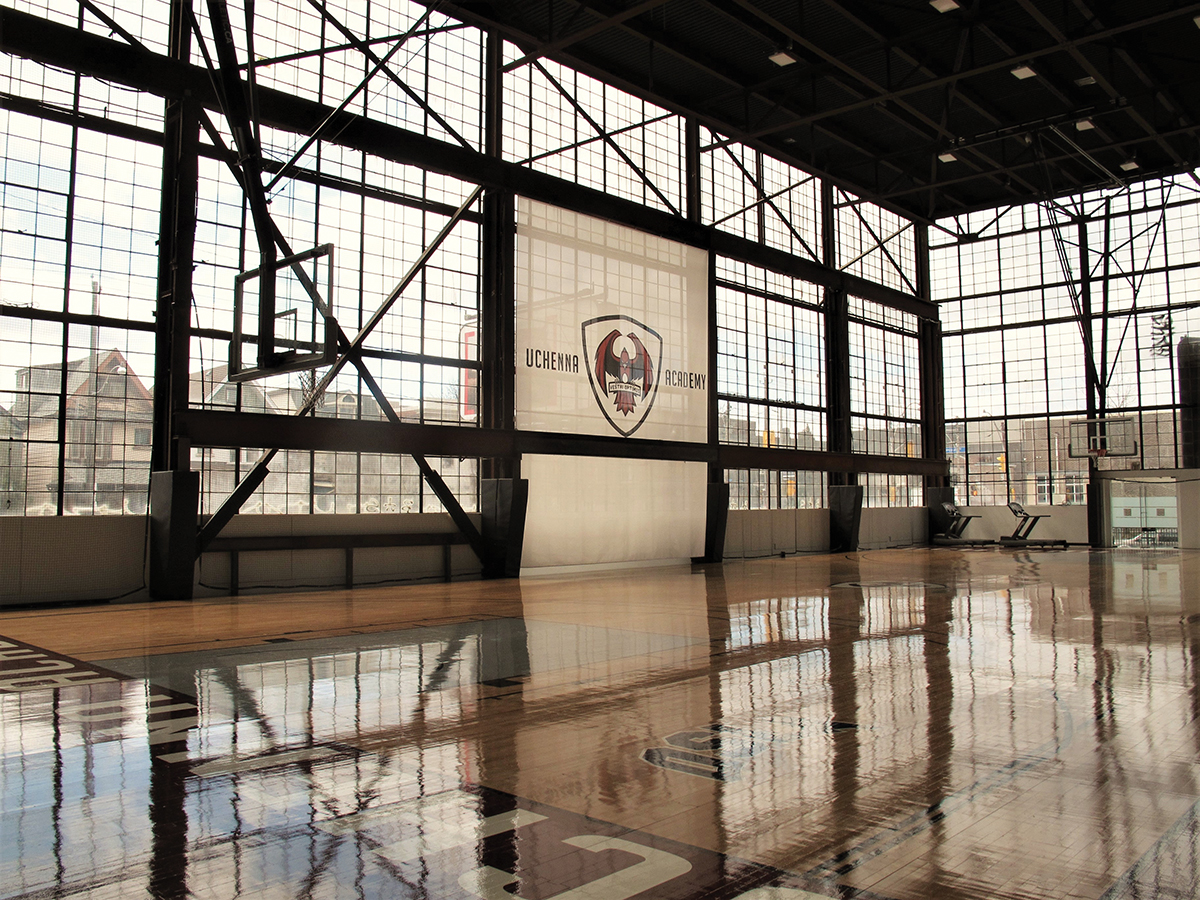
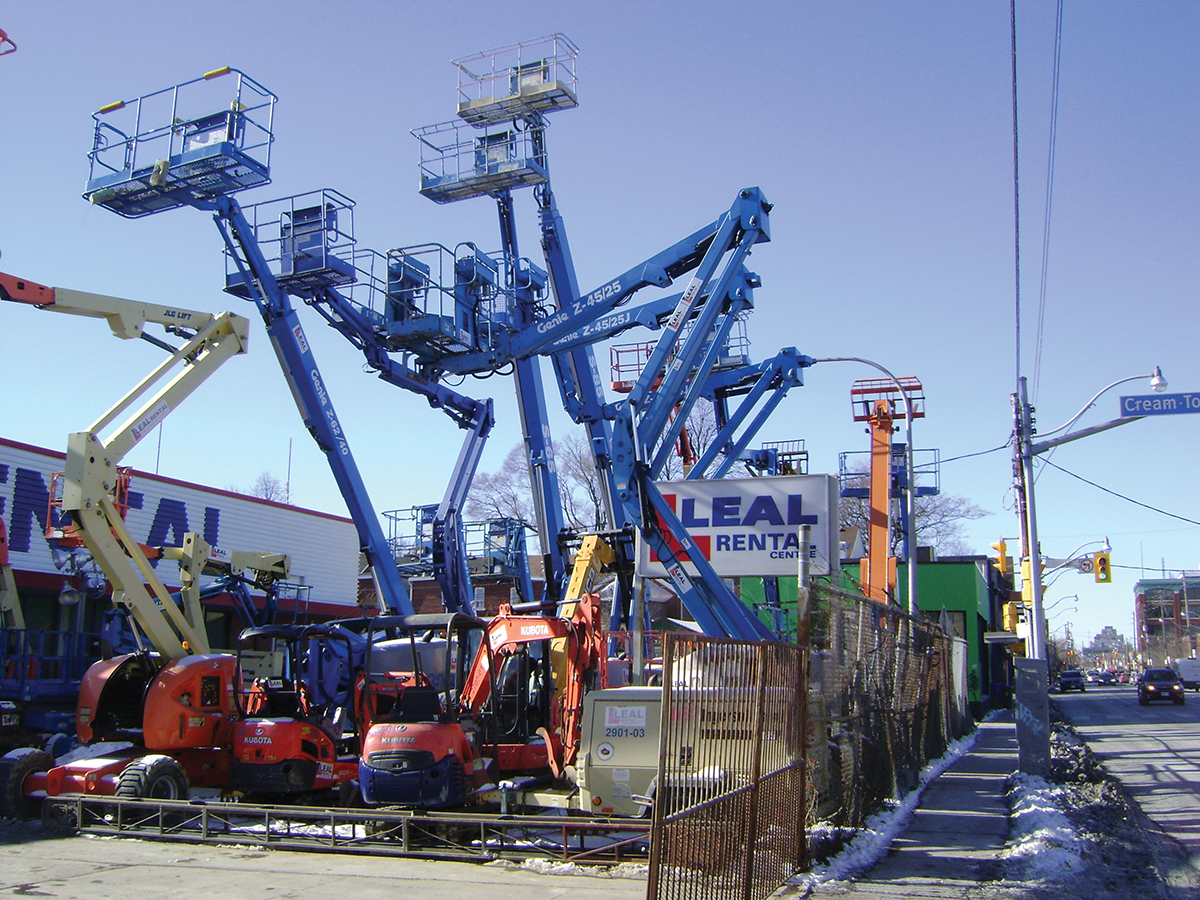
If one thing captures the essence of Dupont Street through all its eras, all up and down its length, it is the business of auto repair. Still today, every day, there are dumpsters, shipping containers even, full of parts coming and going from garages along the street. The innumerable shops’ names hint at specialties: Massive (collision work, east of Lansdowne), Spotless (at Dufferin, with its 1955 Plymouth), and Expert (opposite the Galleria site). Near Bathurst Street, Dupont Transmission and Auto Service changed its name to the anthropomorphic Mister Dupont, scoring one for the street’s humanity.
Nearly anyone with a car in Toronto uses Dupont and likes its directness, if not its perils. The crosstown street was sewn together from other streets, to speed them up, and it did that. In the deadly Dupont dance, the car ahead is never fast enough, you honk at drivers making legal lefts, there is no signalling lane changes. When a no-stopping zone opens the right lane, you whip your S.U.V. over there and boot it, passing on the right, bullying back just before parked cars come up again at the curb.
Dupont’s gas stations are legion. A Pioneer in the curve at Emerson Avenue has been immortalized, in the news, if not novels, for motorists’ willingness to idle in lines for gas that is slightly cheaper than elsewhere. Art has been spotted in such locales. The night of October 31, 1923, a photographer stopped by the one-time Shell at 376 Dupont. In his urban still-life, there is mist in the air, a now vintage car, cobblestones between the trolley tracks. A hundred years later, Toronto designer Jeremy Hopkin dabbled dangerously by colourizing the picture. The canopy’s red tile roof is washed by yellow incandescence. A Shell logo and the words “MOTOR SPIRIT” are aglow. Letters behind the skyscraper gas pump offer “CRASH SERVICE.” Nobody is around.
Recently, I threaded my way between rusty Oldsmobiles to stick a note on the door of the garage at 1072 Dupont. The lot is tiny, the old cars jammed in; mostly Cutlasses, a mid-sized model. There was a big-bumpered nineteen-seventies four-door, and a downsized coupe from the eighties. Another car was under a tarp. Frames from parted-out vehicles leaned on the asphalt shingles of the house to the west. Stepping up to the metal door, I heard a noise inside and decided to knock. “I was looking to talk to you about your Oldsmobile shop,” I said. The cars haven’t been made for twenty years—what gives? A youngish, crisp-looking man opened the door. “Personal hobby,” he said. “I’m in the middle of a service call. Hang around. You can take a look if you like.” His name was Matt, he told me, and he said he’s owned the lot since the nineteen-nineties. An electrician in his regular life, he fixes up the Olds cars here on Dupont, then drives them to somewhere else.
But a hobby is not a business; they live by different rules. At Dupont and Bathurst, a popular coin-op car wash prospered for decades on loonies and toonies (for a time it was called the Loonie Toonie, and, back in the seventies, Sofspray). In the late twenty-tens, one of Toronto’s ubiquitous development signs (“A change is proposed for this site . . .”) appeared at a corner of the lot. We who washed our cars at Loonie Toonie weren’t surprised. I’d long joked with the owner that the property could fund his retirement. He was shy but often presided from a red Ford pickup, his son helping out on the lot. The business had suffered due to years-long street work, not to mention construction of the Bianca next door. So-called “no touch” car washes had come along, and he told me that COVID-19 made cleaning cars “not a priority.” One day in May, 2022, the sprayers went dry, the vacuums were removed, and the premises were surrounded by wire fencing and a Do Not Enter sign.
“You know, there’s not going to be any, any, any garages downtown,” said my mechanic, Angelo Tulipano, who owns a shop at 548 Dupont that has serviced several makes of mine over forty-plus years, including Chevrolet, Chrysler, American Motors, Nissan, and Subaru. Property values and high rent are responsible, but there are bigger, more existential reasons. The reporter-customer in me wonders: Is electricity—electric cars—to auto maintenance what the Internet was to newsprint? Tulipano’s not sure. People are still reading, but, he adds, “the corner stores don’t have newspapers.”
Tulipano is sixty-eight and has been fixing cars since he was fourteen. His garage has two lifts, back to back. Tools are everywhere, in a somewhat orderly fashion. Deep shelving holds jugs of the spirits and solvents of the trade. Customers’ summer tires (“ALFRED, NISSAN MAXIMA,” taped on mine) are in storage on high racks.
Looking around, you see where Tulipano is taking the business for the foreseeable future. Outside is the parade. More precisely, it is a cramped lot full of customers’ vehicles, now mostly classic cars, from DeLoreans to Rolls-Royces to a more plebeian AMC Ambassador. Once, when I was inside Tulipano’s shop, the shell of a sporty Jaguar was balanced at waist height on one of the lifts. It was an ancient and shapely convertible, maybe seventy years old, in blue primer paint.
The garage door opens to the back, into a laneway parallel to the C.P.R. tracks. If Dupont is the speedway, this is the service road, a combination graffiti alley, boneyard, and jungle. In summer, Queen Anne’s lace and wild daylilies threaten to take over. Feral trees have penned in the painter neighbour’s derelict G.M.C. vans, now sunk to their hubcaps in dirt. A half-block away stands the former Model T factory at Christie Street, whose great mass, designed by Ford’s Detroit architect, Albert Kahn, still dominates views along Dupont. The cars were sold in a street-level showroom, amid potted plants; they were repaired at 548, says Tulipano, in his cement-block premises—a fact he checked by seeing his late landlord’s old pictures of the place. A hundred years on, cars are still fixed on the lot. For a while longer, anyway.
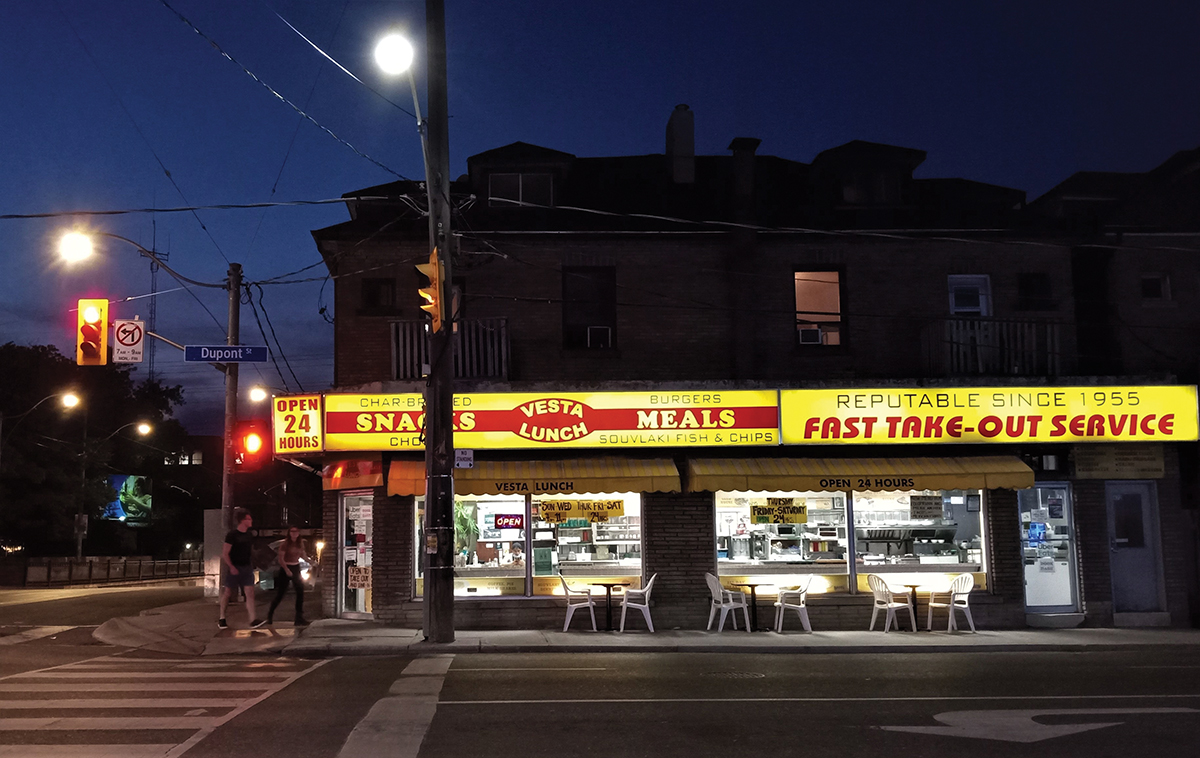
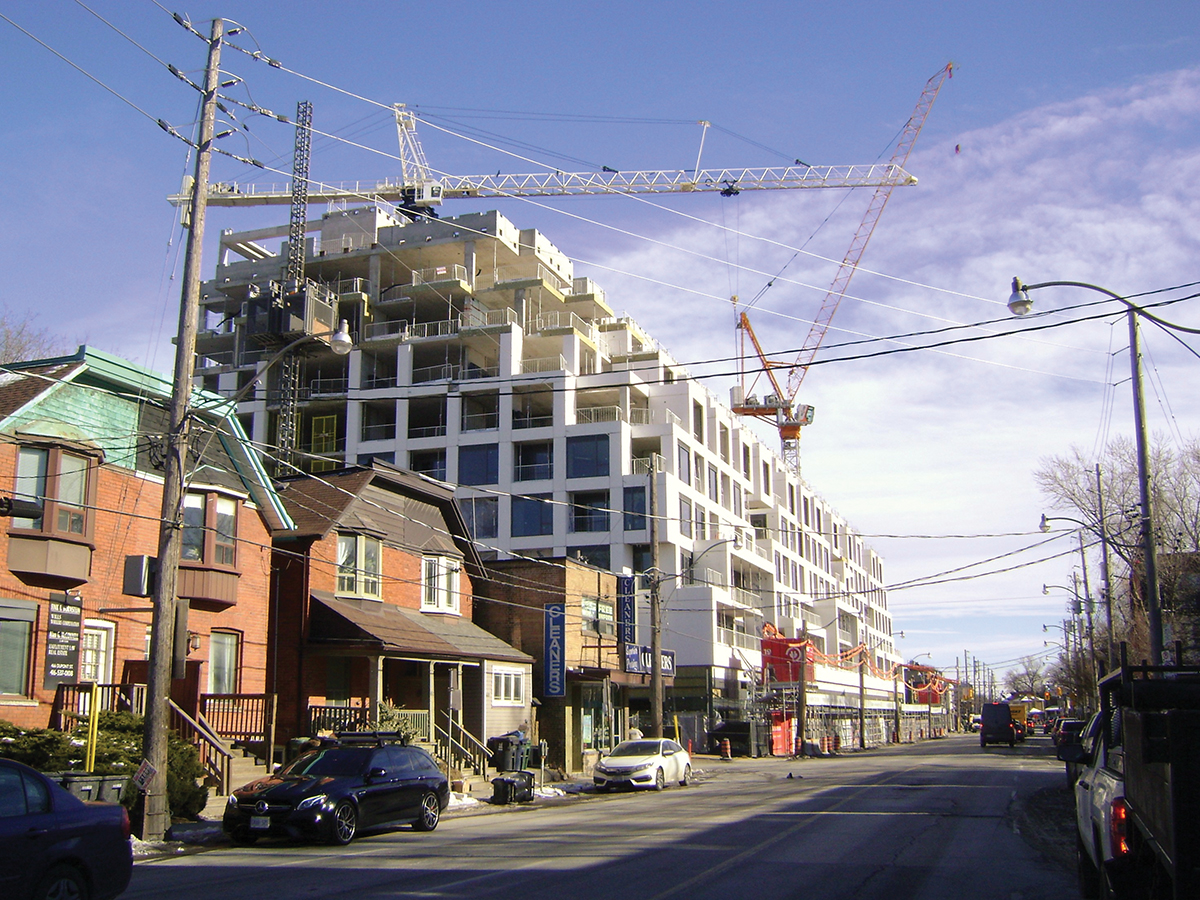
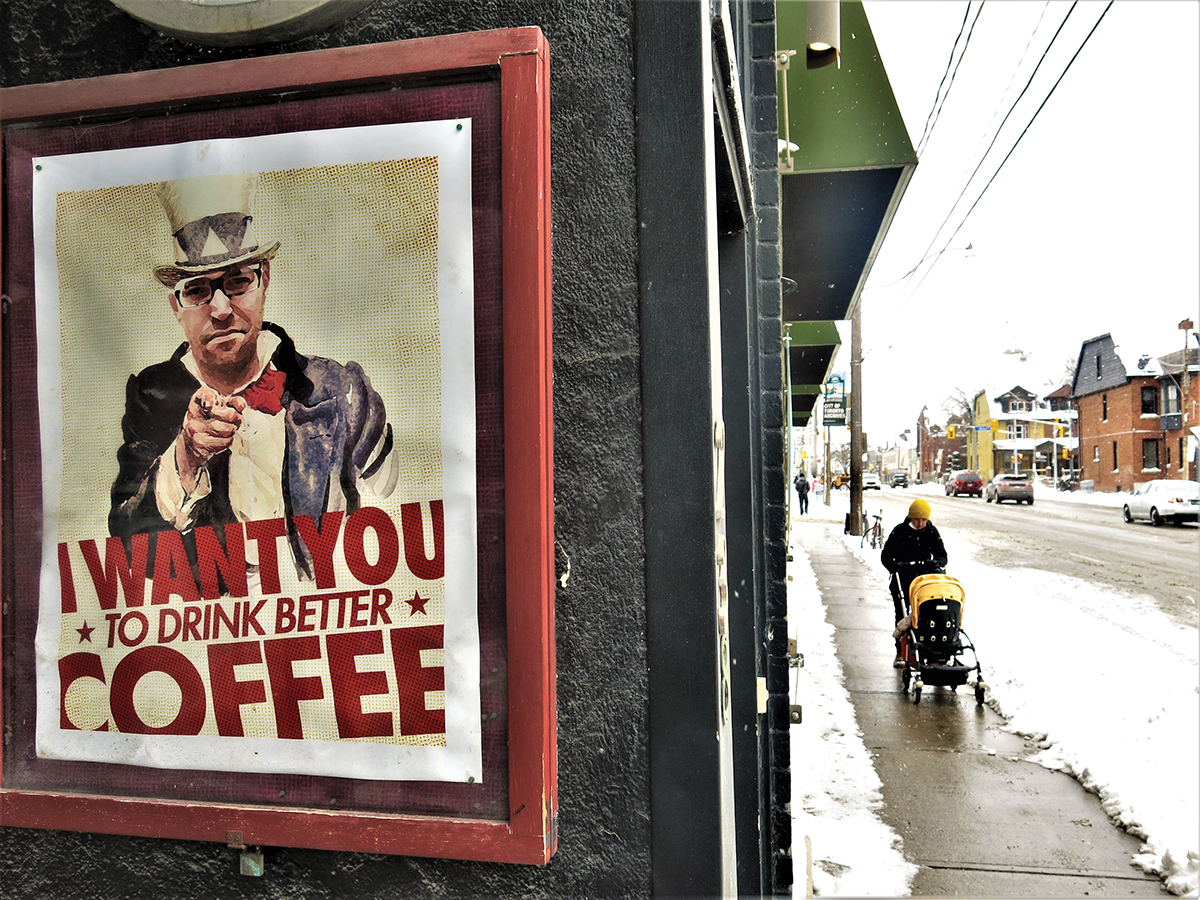
Dupont Street “could become chic,” said Daniel Stubbe, a sixth-generation “konditor” and owner of Stubbe chocolate and pastry shop, at 653 Dupont. The tony store near Christie Street turns out chocolate reindeer, Easter eggs, Halloween goodies—whatever’s in season. Or look in from the Dupont sidewalk: chocolate spheres are piled into mountains, trays of marzipan masquerade as healthy fruit, candy eggs are speckled like Jackson Pollock paintings. Even at Easter of 2021, the height of the pandemic, armies of chocolate rabbits stood at attention behind the plate glass, in Cellophane armour tied with a ribbon at the top, awaiting the marching order for curb delivery.
Stubbe’s shop would fit in nicely off the Grand-Place, in Brussels, surrounded by guild halls. Or—the founding family being German—in Bremen’s quaint Böttcherstraße. But, juxtaposition being in Dupont’s D.N.A., the elegant store faces heavy traffic, across from Loblaws and a door or two from Marlene’s Just Babies. The nearby A&W is over-housed in a 1915 bank building by Hogle & Davis. A few doors east, at 631, sits Roberts Gallery, Canada’s oldest—founded in 1842 and moved to Dupont in 2020—erstwhile dealers for A. J. Casson, York Wilson, Jean-Paul Riopelle.
In something of a paradox, this previously existing Dupont, with its eclectic, frequently avant-garde shops and services, has been a major selling point for the New Dupont gradually replacing it. “It’s people that make a place, and people with their infinite ideas are remaking the Dupont corridor, converting its former factories into welcoming social, work, and entertainment spaces,” the Web site for ELAD’s Galleria site, proclaims. “The New Dupont’s art galleries, restaurants, brew pubs, cafes, and restaurants are exerting an irresistible pull on Torontonians from across the city who are looking for something unique and heart-felt.”
I asked Stubbe, “Are all these new buildings going to be your windfall? Or are they going to do the old displacement thing?” For now he swings with the Farm Boy monkey, optimistic for “foot traffic” in the next era. His hopes are shared by others, from Bespoke Butchers to Nancy’s Cheese, if not the muffler shops that still alternate between them. In Dupont by the Castle, the district south of Casa Loma, cobbler Nick Marinos pivoted to the most obvious upside of more pedestrians: “They all have shoes. They need to get them repaired.” Nick’s Shoes and Repair was, until pulling out for a new, more modern location, at Yonge and Adelaide, this July, one of several narrow storefronts in a generic brick building at St. George Street. In the show window, when Marinos presided, stood a row of miscellaneous boots. Inside was a small area for customers, with a counter and displays of laces, creams, and polishes. Yet spectacle and anomaly were not far away. If you took narrow stairs to the basement, the length of the building opened up. A dozen people sat working amid the flotsam and machinery needed to make, fix, and customize shoes. The “fantastic rumour,” as I called it, was true. When you had your shoes fixed anywhere in town, the work was often sent here. In 2021, after more than fifty years, the family sold the business. A measure of Nick’s clairvoyance, the store’s deep reputation, and the nature of the goods despite a new age, was that no Under New Management sign seemed to have been hung out by the buyer.
Another example of the old Dupont’s persistence was how the street from long ago could jump into the present, like an Edward Hopper painting come to life. Let’s say it’s after dark and you’re driving home hungry. The traffic signal turns red at Bathurst Street. You stop, and there is Vesta Lunch, a down-market Phillies from Hopper’s famous picture. No blinds, so in you look. A couple of people sit on stools at the counter. No fedoras are worn, but the salt and pepper shakers are essentially the same, the napkin dispensers even. The pandemic shortened Vesta’s hours from 24/7. The manager, Maria Lopez, had someone cut out giant letters in Day-Glo paper saying “OPEN TO TAKE OUT” and paste them on the glass. Now that things are returning to normal, is this Bathurst and Dupont scene 1955, 1975, or 2015? (All of the above, except for inflation: the all-day steak and eggs were up to $14.95 by June, 2022.) Lopez was upbeat. The folks on their way to redeem bottles and cans at the Beer Store on Dupont a half-block west disappeared with the building (new condo going up), but construction workers were coming in. Steps away, Bianca was nearing occupancy. Will the new folks be hungry?
Someone banking on that is Anthony Rose, a former restaurant dishwasher who by the twenty-tens was one of Toronto’s most influential foodies. As boys, Rose and his brother ate at People’s Foods, the hole-in-the-wall burger joint at 176 Dupont, its big blinking sign long visible at the top of St. George Street. One day his brother saw a foreclosure notice posted there and Anthony took the spot, opening Rose and Sons. The space was so small that, to make a go of it, he created Big Crow, a barbecue joint with no roof, out back by the train tracks—just a grill and some picnic tables. It worked, and a budding consortium soon filled several other Dupont addresses. They are all on the north side and, come evening, on Dupont’s stretch from Howland Avenue to Davenport Road, the observant will notice couples waiting for breaks in traffic to dash across for dinner. The names, menus, and numbers of Rose’s other restaurants on Dupont are Fat Pasha (edible Middle Eastern still lifes, at 414), Schmaltz (bagels and fish, behind 414), and Fet Zun (rustic Middle Eastern, 252). Big Crow finally got a roof, along with vases of fresh flowers, tiny lights, and humans instead of raccoons. Walking back from the Dupont sidewalk, diners dodged a fire escape, old pipes, and galvanized garbage tins. Weeds like triffids pressed in, but it was still smart to have a reservation. (Rose opted to close the flagship locations this summer, in order to focus on his other Dupont-based concerns.)
“Why are you so invested in—like, it’s a crabby old street,” I asked Rose one evening. It was a “happy accident,” he said—the place where things worked out, as opposed to Queen Street, further south, or Pine Plains, New York, where he ran a tavern for about a year. “And every time something not on Dupont didn’t work,” he said, “I was so happy to, like, not spread my time.” In the promotional magazine for the Bianca condo, there was talk of Rose’s “empire,” of plans for L.A. and New York, of Rose as “the man who would be king.” But behind 176 Dupont, Anthony Rose, comfy in his ripped jeans, talked to me of doing “extreme local,” of running his places happily “hands on” on the “extremely used thoroughfare,” his loyal customers coming in twice a week. A photo in the Bianca magazine shows Rose guzzling a Coca-Cola, touting—as Vesta’s Maria Lopez might—“the simplicity of the food we serve,” which the condo’s copywriter called, at Rose and Sons, “comfortable and familiar, but with that little something extra.”
“Have you ever rented space in new construction?” I asked, suggesting what lies ahead along his favoured boulevard. No—he relies on old buildings. “When you’re signing a lease, you look for five, five, and five. To be able to try to understand what you’re doing for the first five, and then survive for the second five,” and hopefully keep the space going for the next five years. I’m betting the king of Dupont Street will thrive. The question is: as Dupont continues to change, will that be enough for him to survive?
“When you look from afar . . . there’s all these cranes,” I said, talking to Dimitri Levanoff at his studio, way west, where Dupont disappears under train tracks and bridges before turning into Annette Street. “But when you walk it, you see, to some extent, its resistance to change.” We were in reality-check mode in his sky-lit studio. The room was quiet but for cooling fans in plus-sized ink-jet printers. Some developers declare Dupont a “cultural corridor,” for its orbit of galleries, theatres like the Tarragon, even the City of Toronto Archives, but this far west there are empty storefronts. Lavenoff attributes them to legacy, not poverty. Down the street is the Ukrainian Orthodox Church. The Canadian Madeira Club, a Portuguese community centre, is across from that, and Sporting Clube Português de Toronto is down the block. Family and descendants, Lavenoff says, “are living in those places, storefronts, and using them as just flats,” cashing out as prices rise or people die off, but slowly. “The Portuguese base . . . was a foundational kind of society here on this stretch.”
I mention the houses—Dupont’s rows of semis with dirty porches, bottom-slider windows, odd half-turrets upstairs. Their modest yards front the fierce traffic in broken blocks from here to Dupont’s far end at Avenue Road. City zoning puts the big buildings on the north side, smaller ones on the south, so most of the houses will stay. Resistance. “These condos going up right now,” I wonder as Lavenoff and I talk, “is it going to bring some beauty here?” Weirdly, they have so far: at the Litho apartments, the fresh sidewalks are decorated with planters. But the liquor store window displays end abruptly at the property line. Old Dupont resumes to the west, with the dusty, useful yards of New Canadians Lumber, its wood gatehouse dating from who knows when. Yes, resistance.
Climb up onto the West Toronto Railpath bridge, over the street at Dupont’s western terminus, in the Junction Triangle, and it’s possible to watch the traffic flow under you like a two-way river. Looking east, you’ll see cranes, and an endless procession of headlights turning toward you, where Dupont jogs around the Galleria site and there is often dust from construction. More cranes will be coming to Dupont for years to come. What will all this bring twenty-five years from now? Beware my forecasts, as we have seen. I envisage that the Green Line, a linear park along the hydro corridor, will come to pass. That it will be harder to get a new muffler—but that you may not need one. Food will be plentiful. Here’s a gift: I predict the 26 Dupont bus will build back its ridership, with citizens going to work (if people still work, and go to work, in 2047), rather than coming to it, as in Dupont’s factory age. Squinting, peering east from the bicycle bridge at Osler Street through the haze of time, I can see it will be a busy place, but in important ways the same—different jumble, same jungle. And that what you see, and perhaps experience, may be up to you. As the marketing people have masterfully shown, your real view—the outlook that finally applies—is made in your head, not on the street. Dupont in the twenty-first century will be whatever you think it is.